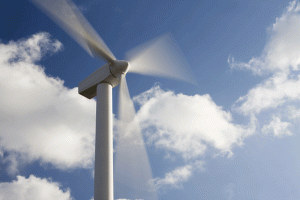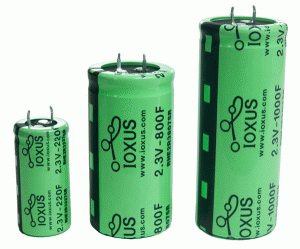Brendan Andrews, Vice President of Sales and Marketing, Ioxus, Inc.
 Cleantech energy is attractive for numerous reasons. Environmental considerations, compounded by the volatility of the oil markets, have spurred recent innovation and investment in solar and wind power generation. In both areas, however, manufacturers have struggled to create an energy source that remains reliable, regardless of meteorological happenings. If cleantech energy is to become viable in wide deployment, it must solve the problem of efficient energy storage to bridge any gaps in production caused by shifts in the weather. The wind turbine market is poised to do just that by swapping its reliance on batteries for smarter components: ultracapacitors.
Cleantech energy is attractive for numerous reasons. Environmental considerations, compounded by the volatility of the oil markets, have spurred recent innovation and investment in solar and wind power generation. In both areas, however, manufacturers have struggled to create an energy source that remains reliable, regardless of meteorological happenings. If cleantech energy is to become viable in wide deployment, it must solve the problem of efficient energy storage to bridge any gaps in production caused by shifts in the weather. The wind turbine market is poised to do just that by swapping its reliance on batteries for smarter components: ultracapacitors.
Ultracapacitors Versus Batteries
Ultracapacitors offer high energy density and power. When used in conjunction with traditional batteries, ultracaps increase the overall power density of an energy source and relieve the typical strains on batteries that can limit their life cycles. Unlike batteries, this component has no plating or chemical reactions to introduce wear. Therefore, ultracapacitors can complete millions of charge and discharge cycles with limited degradation. Any performance fade in the devices are predictable and easily monitored so that the end of application life is predicted. While the replacement period for batteries is between two and four years, the expectation for ultracapacitor lifespan is more than a decade.
This difference in lifespan is no small matter when it comes to wind turbines. Beyond the cost of replacing batteries, swapping out components can be a dangerous task depending on the location and status of individual turbines. The less often operators need to perform these tasks, the better. With batteries, temperature extremes can significantly affect lifespan. Whereas ultracapacitors operate optimally at a temperature range between -40°C and 65°C, batteries function best on a modest spectrum of -20°C to 40°C. When batteries have to operate at the extremes of this spectrum or beyond, they need to be replaced even more often. There is a staggering difference between these two components in terms of cycling capability, as well. The battery can offer 10,000 to 50,000 cycles in comparison to an ultracapacitors’s million-plus cycles.
Perhaps most importantly, batteries do a poor job of delivering the frequent, short power boosts wind turbines need to make rapid rotor blade adjustments and create electricity. The pitch of a wind turbine’s three rotor blades can be adjusted to respond to current conditions and maximize the elements to create clean energy. However, these adjustments create waste, since the energy storage systems frequently used are sized to meet the highest possible power demands, even if those rates only occur briefly and sporadically. Ultracapacitors solve that problem, since they are specifically designed to deliver high power bursts and energy recapture.
On price, too, ultracapacitors beat batteries. During the past 10 years, the price of these components has dropped by 99 percent, from $5,000 for a 3,000 Farad ultracapacitor to $50. In comparison, the cost of a battery during the same time period has fallen 30 to 40 percent.
Expanding Wind Turbine Market Calls for Better Energy Storage
 For many of the same reasons why the wind turbine market is picking up after several flat years, the manufacturers who supply this space are making changes to their energy storage strategies. Estimates for new installed capacity through 2015 suggest a rebound in growth. If this new generation of wind turbines is to fulfill the promises of cleantech power generation, their makers must solve the problem of efficient, reliable energy storage. Ultracapacitors deliver that solution.
For many of the same reasons why the wind turbine market is picking up after several flat years, the manufacturers who supply this space are making changes to their energy storage strategies. Estimates for new installed capacity through 2015 suggest a rebound in growth. If this new generation of wind turbines is to fulfill the promises of cleantech power generation, their makers must solve the problem of efficient, reliable energy storage. Ultracapacitors deliver that solution.
Today’s wind turbines offer pitch control for each of three blades, ensuring optimum positioning for efficient use of wind speed for both performance and safety. That pitch control is derived either mechanically or electrically, but electrical control systems replace mechanical movements with more reliable electrical systems. However, when electrical control systems rely on battery-based backup systems, the potential maintenance advantage over hydraulic systems is not necessarily realized. For this reason, designs for backup in the past few years have included ultracapacitors rather than batteries.
Electrical pitch controlled systems have certainly won the favor of the market; current estimates show that 60 percent of newly installed turbine systems are electrical pitch controlled systems. This share should continue to expand as more new turbine developments focus on electrical-based systems enabled by ultracapacitors.
Ultracapacitors are in use in 14,000 turbine installations, where they are solving the peak-power and storage problems that once limited the market. Ultracapacitor’s offer advantages over batteries, including lifecycle length, temperature tolerance, reliability, cost and operational safety. By solving many of the problems battery-powered energy storage represented to the market, ultracapacitors are helping wind turbine manufacturers harness the elements to create clean, green, cost-effective energy.
Brendan Andrews is the vice president of sales and marketing at Ioxus, Inc. He is responsible for the leadership and coordination of Ioxus’ sales and marketing functions and for educating the global market regarding existing and future ultracapacitor technologies. For more information, please contact Ioxus, Inc. at www.ioxus.com.
This article appeared in the May/June 2011 issue of Battery Power magazine.







